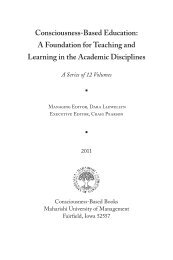The Bhagavad-Gita: A Case Study in Vedic Psychology - Maharishi ...
The Bhagavad-Gita: A Case Study in Vedic Psychology - Maharishi ...
The Bhagavad-Gita: A Case Study in Vedic Psychology - Maharishi ...
Create successful ePaper yourself
Turn your PDF publications into a flip-book with our unique Google optimized e-Paper software.
MODERN SCIENCE AND VEDIC SCIENCE<br />
consciousness as an experience of <strong>in</strong>ner contentment that is most charm<strong>in</strong>g or fulfill<strong>in</strong>g.<br />
<strong>Maharishi</strong> offers the <strong>Vedic</strong> technology he has brought to light <strong>in</strong> the Transcendental<br />
Meditation (TM) technique as the systematic means to ga<strong>in</strong> the experience of transcendental<br />
consciousness and develop higher states of consciousness outl<strong>in</strong>ed by the<br />
<strong>Bhagavad</strong>-<strong>Gita</strong>. <strong>Maharishi</strong> (1967) describes his Transcendental Meditation technique<br />
"as turn<strong>in</strong>g the attention <strong>in</strong>wards towards the subtler levels of a thought until the m<strong>in</strong>d<br />
transcends the experience of the subtlest state of the thought and arrives at the source of<br />
thought" (p. 470)—that is, pure consciousness. Because "subtler" or less excited states<br />
of awareness are more fulfill<strong>in</strong>g or charm<strong>in</strong>g, <strong>Maharishi</strong> also notes that this process is<br />
effortless: once given the proper direction, the attention automatically progresses to subtler<br />
levels until the experience of transcendental or pure consciousness is ga<strong>in</strong>ed. <strong>The</strong><br />
Transcendental Meditation technique thus differs from any technique of concentration,<br />
which attempts to use effort to quiet mental activity.<br />
This description is found <strong>in</strong> Lord Krishna's characterization of the Self as a state of<br />
awareness without mental activity, "beyond the <strong>in</strong>tellect" (III. 43). Moreover, the effortlessness<br />
of Transcendental Meditation is expressed <strong>in</strong> Lord Krishna's description of Yog<br />
as <strong>in</strong>volv<strong>in</strong>g "no effort" and "no obstacle" (II. 40). F<strong>in</strong>ally, Lord Krishna's assertion that<br />
the Self is characterized by "contentment" (III. 17; VI. 20) describes clearly the mechanics<br />
of the Transcendental Meditation technique as outl<strong>in</strong>ed above.<br />
<strong>The</strong> <strong>Bhagavad</strong>-<strong>Gita</strong> also describes the fundamental pr<strong>in</strong>ciple of the <strong>Maharishi</strong><br />
Sidhi program. <strong>Maharishi</strong> translates Lord Krishna's words <strong>in</strong> the follow<strong>in</strong>g way:<br />
"Curv<strong>in</strong>g onto my own nature, I create aga<strong>in</strong> and aga<strong>in</strong>" (IX. 8). This pr<strong>in</strong>ciple of creation<br />
from the field of pure consciousness, and the mechanics of the TM-Sidhi program,<br />
are discussed <strong>in</strong> Gelderloos and Berg (1989). <strong>Maharishi</strong> (1986a) also comments on a<br />
later verse of the <strong>Bhagavad</strong>-<strong>Gita</strong> (IX. 10), <strong>in</strong> which Lord Krishn expresses the process<br />
by which the field of pure consciousness gives rise to the creative process <strong>in</strong> nature, yet<br />
rema<strong>in</strong>s the non-chang<strong>in</strong>g basis of all change:<br />
"Under my presidency, my nature creates aga<strong>in</strong> and aga<strong>in</strong>." That means, "I rema<strong>in</strong> un<strong>in</strong>volved."<br />
<strong>The</strong> self-referral <strong>in</strong>telligence at the unmanifest basis of creation rema<strong>in</strong>s un<strong>in</strong>volved<br />
<strong>in</strong> the creative process, but the creative process owes its emergence and draws its<br />
vitality from that self-referral performance of pure <strong>in</strong>telligence. (p. 30)<br />
TM-<br />
Please refer to Dillbeck (1988) for a further description of this creative process found <strong>in</strong><br />
<strong>Maharishi</strong> <strong>Vedic</strong> <strong>Psychology</strong>.<br />
In summary, Lord Krishn declares to Arjun that there is a field of pure consciousness<br />
which is without diversity or change. It is described as one's own "Self," experienced<br />
when the m<strong>in</strong>d settles to its most silent state of awareness. Lord Krishn <strong>in</strong>dicates that<br />
this state is not usually experienced because desire directs attention outward to the<br />
objects of the senses. However, given the proper procedure, pure consciousness is easily<br />
and effortlessly experienced because it provides experience of joy and contentment<br />
greater than that given by sensory pleasure. F<strong>in</strong>ally, Lord Krishn affirms that suffer<strong>in</strong>g<br />
is ended when the experience of pure consciousness is permanently established. This<br />
occurs <strong>in</strong> the development of higher states of consciousness, or enlightenment.<br />
118

















